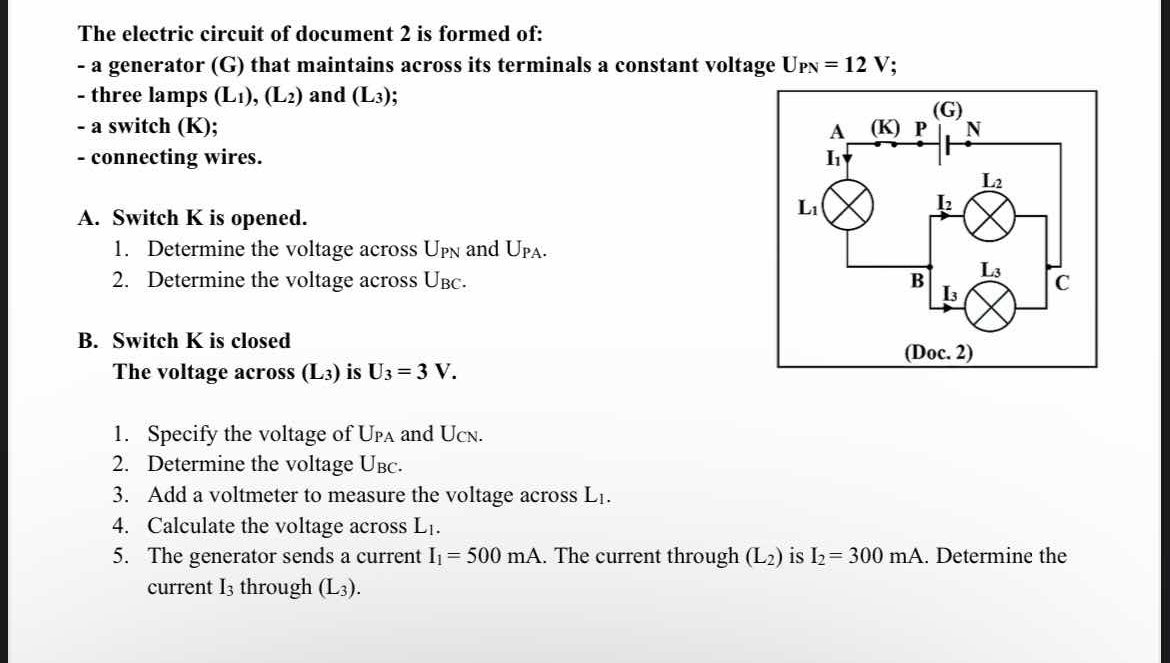The electric circuit of document 2 is formed of a generator, three lamps, a switch, and connecting wires. When switch K is opened, determine the voltage across UPN and UPA, and the... The electric circuit of document 2 is formed of a generator, three lamps, a switch, and connecting wires. When switch K is opened, determine the voltage across UPN and UPA, and the voltage across UBC. When switch K is closed and the voltage across L3 is 3V, specify the voltage of UPA and UCN, determine the voltage UBC, add a voltmeter to measure the voltage across L1, calculate the voltage across L1, and determine the current through L3 given that I1 is 500 mA and I2 is 300 mA.

Understand the Problem
The question is asking to analyze an electric circuit and calculate various voltages based on different conditions (switch opened and closed). It involves determining voltages across different elements in the circuit and using given current values.
Answer
1. \( U_{PA} = 6 \, \text{V}, U_{CN} = 6 \, \text{V}, U_{BC} = 6 \, \text{V} \) (switch opened) 2. \( U_{PA} = 4.5 \, \text{V}, U_{CN} = 4.5 \, \text{V}, U_{BC} = 9 \, \text{V} \) (switch closed)
Answer for screen readers
-
( U_{PA} = 6 , \text{V} ), ( U_{CN} = 6 , \text{V} ), and ( U_{BC} = 6 , \text{V} ) when the switch is opened.
-
( U_{PA} = 4.5 , \text{V} ), ( U_{CN} = 4.5 , \text{V} ), and ( U_{BC} = 9 , \text{V} ) when the switch is closed.
Steps to Solve
- Analyzing the Circuit with Switch K Opened
When the switch ( K ) is opened, the circuit is broken. The total voltage across the generator ( U_{PN} = 12 , \text{V} ) will be dropped across the lamps ( L_1 ) and ( L_2 ).
- Determining Voltage Across ( U_{PA} ) and ( U_{PN} )
Since the total voltage from the generator is ( 12 , \text{V} ), and considering an ideal situation where there's no voltage drop across the wires, we have:
$$ U_{PA} + U_{CN} = U_{PN} = 12 , \text{V} $$
If both lamps ( L_1 ) and ( L_2 ) have equal resistance, then they will share the voltage equally.
- Using Voltage Divider Rule
Assuming equal resistance for ( L_1 ) and ( L_2 ):
$$ U_{PA} = U_{CN} = \frac{U_{PN}}{2} = \frac{12 , \text{V}}{2} = 6 , \text{V} $$
- Determining Voltage Across ( U_{BC} )
To find ( U_{BC} ), observe that it is the voltage across the two lamps in parallel, which must be equal:
$$ U_{BC} = U_{PA} = 6 , \text{V} $$
- Switch K is Closed
Now we analyze the circuit when switch ( K ) is closed. The voltage across lamp ( L_3 ) is given as ( U_3 = 3 , \text{V} ).
- Determining Voltages Across ( U_{PA} ) and ( U_{CN} )
Using Kirchhoff's Voltage Law, the total voltage must equal the sum of the voltages across the components. Since ( U_{3} = 3 , \text{V} ):
$$ U_{PA} + U_{CN} + U_3 = U_{PN} $$
Therefore:
$$ U_{PA} + U_{CN} + 3 , \text{V} = 12 , \text{V} $$
From this equation:
$$ U_{PA} + U_{CN} = 12 , \text{V} - 3 , \text{V} = 9 , \text{V} $$
- Dividing Voltage Between ( U_{PA} ) and ( U_{CN} )
Assuming ( U_{PA} = U_{CN} ):
$$ U_{PA} = U_{CN} = \frac{9 , \text{V}}{2} = 4.5 , \text{V} $$
- Determining Voltage Across ( U_{BC} )
The voltage ( U_{BC} ) across the two parallel lamps can be calculated similarly or verified through Kirchhoff’s Law:
$$ U_{BC} = U_{PN} - U_{3} = 12 , \text{V} - 3 , \text{V} = 9 , \text{V} $$
- Calculating Voltage Across ( L_1 )
Using voltage division:
If ( I_1 = 500 , \text{mA} ) and ( I_2 = 300 , \text{mA} ) are the currents through ( L_1 ) and ( L_2 ), then
$$ I_3 = I_1 - I_2 = 500 , \text{mA} - 300 , \text{mA} = 200 , \text{mA} $$
Assuming equal resistance, we can calculate voltage across ( L_1 ) using Ohm's Law.
-
( U_{PA} = 6 , \text{V} ), ( U_{CN} = 6 , \text{V} ), and ( U_{BC} = 6 , \text{V} ) when the switch is opened.
-
( U_{PA} = 4.5 , \text{V} ), ( U_{CN} = 4.5 , \text{V} ), and ( U_{BC} = 9 , \text{V} ) when the switch is closed.
More Information
The calculations assume ideal circuit conditions. In real scenarios, factors like resistance and internal characteristics of lamps may slightly alter voltage readings.
Tips
- Forgetting to account for all resistances when calculating voltage drops.
- Not applying Kirchhoff's Laws correctly in a closed circuit.
AI-generated content may contain errors. Please verify critical information